Bionic Design and Optimization of the Wear-Resistant Structure of Piston Rings in Internal Combustion Engines
Abstract
:1. Introduction
2. Materials and Methods
2.1. Design of Bionic Piston Ring
2.2. Finite Element Method (FEM) Analysis of Piston Rings
2.2.1. Analysis Model and Boundary Conditions
2.2.2. Wear Resistance Validation Test
3. Results and Discussion
3.1. Results of FEM
| Serial Number | Depth D/mm | Width W/mm | Spacing L/mm | Max Stress yi/MPa |
|---|---|---|---|---|
| 1 | 1 | 0.1 | 0.1 | 450.7 |
| 2 | 1 | 0.1 | 0.2 | 348.4 |
| 3 | 1 | 0.1 | 0.3 | 379.1 |
| 4 | 1 | 0.3 | 0.1 | 489 |
| 5 | 1 | 0.3 | 0.2 | 380.1 |
| 6 | 1 | 0.3 | 0.3 | 449.2 |
| 7 | 1 | 0.5 | 0.1 | 416.4 |
| 8 | 1 | 0.5 | 0.2 | 595.4 |
| 9 | 1 | 0.5 | 0.3 | 455.6 |
| 10 | 2 | 0.1 | 0.1 | 354.6 |
| 11 | 2 | 0.1 | 0.2 | 358.6 |
| 12 | 2 | 0.1 | 0.3 | 349.9 |
| 13 | 2 | 0.3 | 0.1 | 449.5 |
| 14 | 2 | 0.3 | 0.2 | 362.6 |
| 15 | 2 | 0.3 | 0.3 | 361.7 |
| 16 | 2 | 0.5 | 0.1 | 391.1 |
| 17 | 2 | 0.5 | 0.2 | 359.4 |
| 18 | 2 | 0.5 | 0.3 | 443.9 |
| 19 | 3 | 0.1 | 0.1 | 339.1 |
| 20 | 3 | 0.1 | 0.2 | 349.2 |
| 21 | 3 | 0.1 | 0.3 | 340.6 |
| 22 | 3 | 0.3 | 0.1 | 340.8 |
| 23 | 3 | 0.3 | 0.2 | 472.2 |
| 24 | 3 | 0.3 | 0.3 | 354 |
| 25 | 3 | 0.5 | 0.1 | 385.2 |
| 26 | 3 | 0.5 | 0.2 | 498.6 |
| 27 | 3 | 0.5 | 0.3 | 392.6 |
| 440.43 | 363.36 | 401.82 | ||
| 381.26 | 406.57 | 413.83 | ||
| 385.81 | 437.58 | 391.84 | ||
| 59.18 | 74.22 | 21.99 | ||
| Order of importance | W > D > L | |||
3.2. Results of Wear Resistance Validation
4. Discussion
5. Conclusions
Author Contributions
Funding
Data Availability Statement
Conflicts of Interest
References
- Dziubak, T.; Dziubak, S.D. A Study on the Effect of Inlet Air Pollution on the Engine Component Wear and Operation. Energies 2022, 15, 1182. [Google Scholar] [CrossRef]
- Du, F.; Li, D.; Hao, M.; Yu, Y.; Wang, W. Simulation and Experimental Research on the Failure of Marine Sliding Bearings. J. Mar. Sci. Eng. 2023, 11, 61. [Google Scholar] [CrossRef]
- Delprete, C.; Razavykia, A. Piston ring–liner lubrication and tribological performance evaluation: A review. Proc. Inst. Mech. Eng. Part J J. Eng. Tribol. 2018, 232, 193–209. [Google Scholar] [CrossRef]
- Holmberg, K.; Andersson, P.; Erdemir, A. Global energy consumption due to friction in passenger cars. Tribol. Int. 2012, 47, 221–234. [Google Scholar] [CrossRef]
- Wong, W.; Tung, C. Overview of automotive engine friction and reduction trends–effects of surface, material, and lubricant-additive technologies. Friction 2016, 4, 1–28. [Google Scholar] [CrossRef]
- Taylor, C.M. Automobile engine tribology-design considerations for efficiency and durability. Wear 1998, 221, 1–8. [Google Scholar] [CrossRef]
- Sreenath, A.V.; Venkatesh, S. Analysis and computation of the oil film thickness between the piston ring and cylinder liner of an internal combustion engine. Int. J. Mech. Sci. 1973, 15, 605–611. [Google Scholar] [CrossRef]
- Wopelka, T.; Cihak-Bayr, U.; Lenauer, C.; Ditrói, F.; Takács, S.; Sequard-Base, J.; Jech, M. Wear of different material pairings for the cylinder liner–piston ring contact. Ind. Lubr. Tribol. 2018, 70, 687–699. [Google Scholar] [CrossRef]
- Budzyński, P.; Kamiński, M.; Pyszniak, K. The influence of nitrogen ion implantation on the tribological properties of piston rings made of Hardox and Raex steels. IOP Conf. Ser. Mater. Sci. Eng. 2016, 148, 012044. [Google Scholar] [CrossRef]
- Bolander, N.W.; Sadeghi, F. Surface Modification for Piston Ring and Liner; Springer: Dordrecht, The Netherlands, 2006. [Google Scholar]
- Jayanth, P.; Sangeethkumar, E. Investigation and Analysis of Wear Reduction in Piston Rings through Coating. Appl. Mech. Mater. 2015, 813–814, 874–879. [Google Scholar]
- Hui, W.; Xia, W.; Jin, Y. A study on abrasive resistance of Ni-based coatings with a WC hard phase. Wear 1996, 195, 47–52. [Google Scholar]
- Tung, S.C.; Gao, H. Tribological Investigation of Piston Ring Coatings Operating in an Alternative Fuel and Engine Oil Blend. Tribol. Trans. 2002, 45, 381–389. [Google Scholar] [CrossRef]
- Mobarak, H.; Masjuki, H.; Mohamad, E.N.; Rahman, S.A.; Al Mahmud, K.; Habibullah, M.; Salauddin, S. Effect of DLC Coating on Tribological Behavior of Cylinder Liner-piston Ring Material Combination When Lubricated with Jatropha Oil. Procedia Eng. 2014, 90, 733–739. [Google Scholar] [CrossRef]
- Madej, M.; Ozimina, D.; Gałuszka, R.; Gałuszka, G. Corrosion, friction and wear performance of diamond-like carbon (DLC) coatings. Metalurgija 2016, 55, 679–682. [Google Scholar]
- Mustafi, L.; Rahman, M.M.; Alam Al Nasim, M.N.E.; Chowdhury, M.A.; Monir, M.H. Deposition behavior and tribological properties of diamond-like carbon coatings on stainless steels via chemical vapor deposition. Int. J. Miner. Metall. Mater. 2018, 25, 1335–1343. [Google Scholar] [CrossRef]
- Vysotina, E.A.; Kazakov, V.A.; Polyansky, M.N.; Savushkina, S.V.; Sivtsov, K.I.; Sigalaev, S.K.; Lyakhovetsky, M.A.; Mironova, S.A.; Zilova, O.S. Investigation of the Structure and Functional Properties of Diamond-Like Coatings Obtained by Physical Vapor Deposition. J. Surf. Investig. X-Ray Synchrotron Neutron Tech. 2017, 11, 1177–1184. [Google Scholar] [CrossRef]
- Di, Y.; Cai, Z.; Zhang, P. Investigation of Microstructure and Tribological Properties of Novel Composite Films. IEEE Trans. Plasma Sci. 2011, 39, 3155–3158. [Google Scholar] [CrossRef]
- Tomanik, E.; Fujita, H.; Sato, S.; Paes, E.; Galvao, C.; Morais, P. Investigation of PVD Piston Ring Coatings with Different Lubricant Formulations. In Proceedings of the ASME 2017 Internal Combustion Engine Division Fall Technical Conference, Seattle, WA, USA, 15–18 October 2017. [Google Scholar]
- Di, Y.; Cai, Z.; Zhang, P. The Tribological Performance of CrMoN/MoS2 Solid Lubrication Coating on a Piston Ring. Lubricants 2017, 5, 13. [Google Scholar] [CrossRef]
- Amirabbas, A.; Khonsari, M. Effect of Untampered Plasma Coating and Surface Texturing on Friction and Running-in Behavior of Piston Rings. Coatings 2018, 8, 110. [Google Scholar]
- Liang, X.; Wang, X.; Liu, Y.; Wang, X.; Shu, G.; Zhang, Z. Simulation and Experimental Investigation on Friction Reduction by Partial Laser Surface Texturing on Piston Ring. Tribol. Trans. 2019, 63, 1–17. [Google Scholar] [CrossRef]
- Peng, E.; Huang, S. Wear performance of cylinder liner surface texturing on cylinder liner-piston ring assembly. Proc. Inst. Mech. Eng. Part J J. Eng. Tribol. 2017, 232, 135065011771343. [Google Scholar] [CrossRef]
- Shen, C.; Khonsari, M.M. Tribological and Sealing Performance of Laser Pocketed Piston Rings in a Diesel Engine. Tribol. Lett. 2016, 64, 26. [Google Scholar] [CrossRef]
- Zhang, Y.L.; Zhang, X.G.; Wu, T.H.; Xie, Y.B. Effects of surface texturing on the tribological behavior of piston rings under lubricated conditions. Ind. Lubr. Tribol. 2016, 68, 158–169. [Google Scholar] [CrossRef]
- Vb, P.; Syed, I.; Beera, S.B. Influence of positive texturing on friction and wear properties of piston ring-cylinder liner tribo pair under lubricated conditions. Ind. Lubr. Tribol. 2019, 71, 515–524. [Google Scholar]
- Liu, J.; Zhang, Y.; Liao, B. A review on preparation process and tribological performance of coatings for internal combustion engine piston ring. Adv. Mech. Eng. 2023, 15, 16878132231175752. [Google Scholar] [CrossRef]
- Liu, C.; Yan, Z.; Dai, W.; He, L.; Jia, X.; Zhang, L. Experimental research on piston rings with different end face structures. Proc. Inst. Mech. Eng. Part J. J. Eng. Tribol. 2023, 237, 636–644. [Google Scholar] [CrossRef]
- Tavsan, F.; Sonmez, E. Biomimicry in Furniture Design. Procedia–Soc. Behav. Sci. 2015, 197, 2285–2292. [Google Scholar] [CrossRef]
- Gu, Y.Q.; Dai, D.S.; Mou, J.G.; Zheng, S.H.; Wu, D.H.; Wang, E. Overview of the technology of bionic surface drag reduction. J. Biomim. Biomater. Biomed. Eng. 2015, 23, 59–66. [Google Scholar]
- Ma, Y.; Wang, H.; Xiao, Y.; Fan, X.; Tong, J.; Guo, L.; Tian, L. Friction and wear behaviour of steel with bionic non-smooth surfaces during sliding. Mater. Sci. Technol. 2016, 32, 257–265. [Google Scholar] [CrossRef]
- Gao, T.Y.; Wang, X.J.; Sun, Y.W.; Cheng, X.J.; Cong, Q. Friction and wear performance of bionic stripped piston of BW-160 slime pump. Proc. Inst. Mech. Eng. Part C J. Mech. Eng. Sci. 2019, 234, 872–881. [Google Scholar] [CrossRef]
- Qin, S.; Peng, Z.; Shi, X.; Xue, Y.; Zhang, K.; Huang, Q. Optimization of Textured Parameters to Improve the Tribological Behavior of TC4-Based Bionic Coating Using RSM. Tribol. Trans. 2022, 65, 441–456. [Google Scholar] [CrossRef]
- Yang, X.; Fu, Y.; Ji, J. Effect of laser bump texture combination characteristics on friction-wear properties of roll surface. Ind. Lubr. Tribol. 2022, 74, 522–530. [Google Scholar] [CrossRef]
- Xiong, Y.; Kong, D. Experimental study on the aerodynamic performance of the bionic rotor blades with non-smooth surface. In Proceedings of the 2021 IEEE International Conference on Artificial Intelligence and Industrial Design: IEEE International Conference on Artificial Intelligence and Industrial Design (AIID 2021), Guangzhou, China, 28–30 May 2021; pp. 421–427. [Google Scholar]
- Huang, M.; Li, K.; Dong, X. Study on Friction Characteristics of Laser Textured Metal Rubber Microfilaments under Solid Lubricating Grease. Prot. Met. Phys. Chem. Surf. 2021, 57, 361–366. [Google Scholar] [CrossRef]
- Zhang, R.; Han, D.; He, Y.; Wan, H.; Ma, S.; Li, J. Drag reduction and wear resistance mechanisms of a bionic shovel by discrete element method simulation. Simulation 2019, 95, 231–239. [Google Scholar] [CrossRef]
- Liu, G.; Wu, X.; Zou, M.; Yan, Y.; Li, J. Experimental Study on Drag Reduction Characteristics of Bionic Earthworm Self-Lubrication Surface. Appl. Bionics Biomech. 2019, 2019, 4984756. [Google Scholar] [CrossRef]
- Jia, H.; Wang, W.; Wang, W.; Zheng, J.; Wang, Q.; Zhuang, J. Application of anti-adhesion structure based on earthworm motion characteristics. Soil Tillage Res. 2018, 178, 159–166. [Google Scholar] [CrossRef]
- Liu, J.; Li, P.; Zuo, S. Actuation and design innovations in earthworm-inspired soft robots: A review. Front. Bioeng. Biotechnol. 2023, 11, 1088105. [Google Scholar] [CrossRef]
- Zhang, D.G.; Chen, Y.X.; Ma, Y.H.; Guo, L.; Sun, J.Y.; Tong, J. Earthworm epidermal mucus: Rheological behavior reveals drag-reducing characteristics in soil. Soil Tillage Res. 2016, 158, 57–66. [Google Scholar] [CrossRef]
- Zhao, H.; Sun, Q.; Deng, X.; Cui, J. Earthworm-Inspired Rough Polymer Coatings with Self-Replenishing Lubrication for Adaptive Friction-Reduction and Antifouling Surfaces. Adv. Mater. 2018, 30, 1802141.1–1802141.6. [Google Scholar] [CrossRef]
- Tong, J.W.; Li, L.A.; Li, H.Q.; Wen, S.Q.; Liu, G.L. 3-D Finite Element Analysis of Stress and Deformation of Piston under the Action of Thermal and Mechanical Load. Trans. Csice 1995, 13, 123–131. [Google Scholar]
- Bing, L.I.; Li, H.Y.; Yao, C.F. Finite Element Analysis of Stress and Deformation of Piston under the Action of Thermal and Mechanical Load. Mech. Sci. Technol. 2002, 21, 222–223. [Google Scholar]
- Zhang, J.N.; Zhang, X.X.; Li, Z.; Xie, Y.B. Transient analysis of piston second-order motion and piston skirt friction. J. Tribol. 2010, 30, 184–189. [Google Scholar]
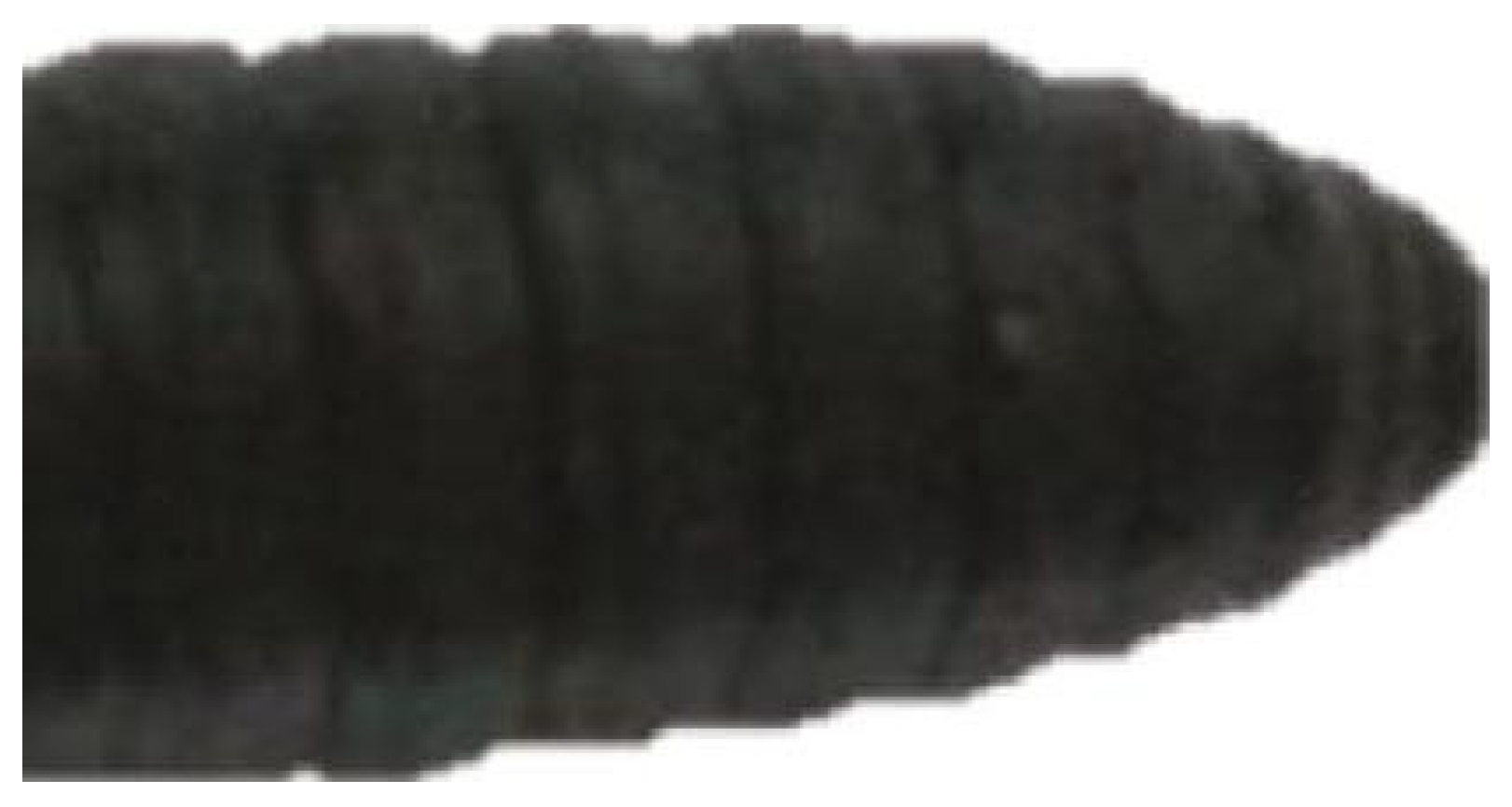

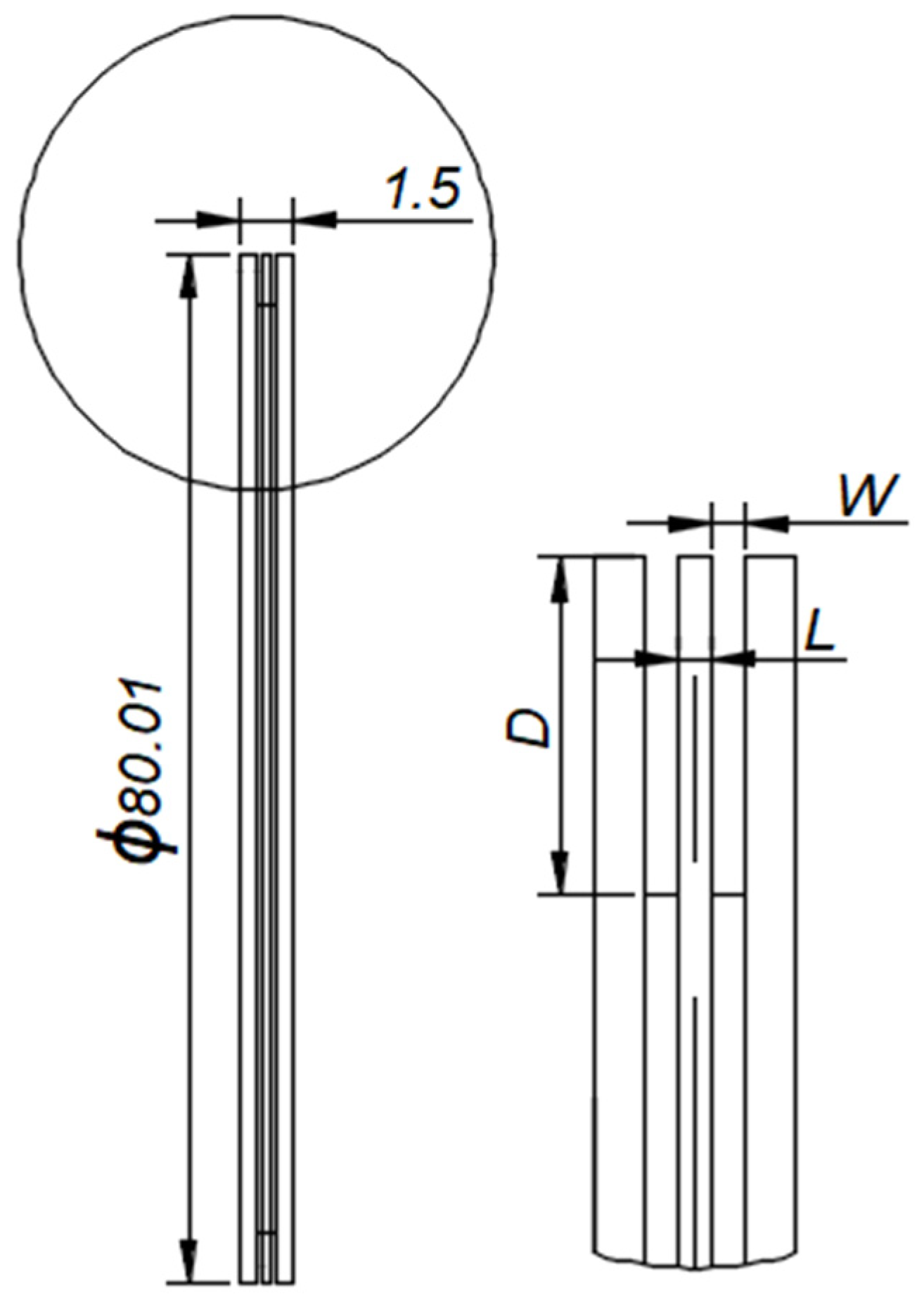

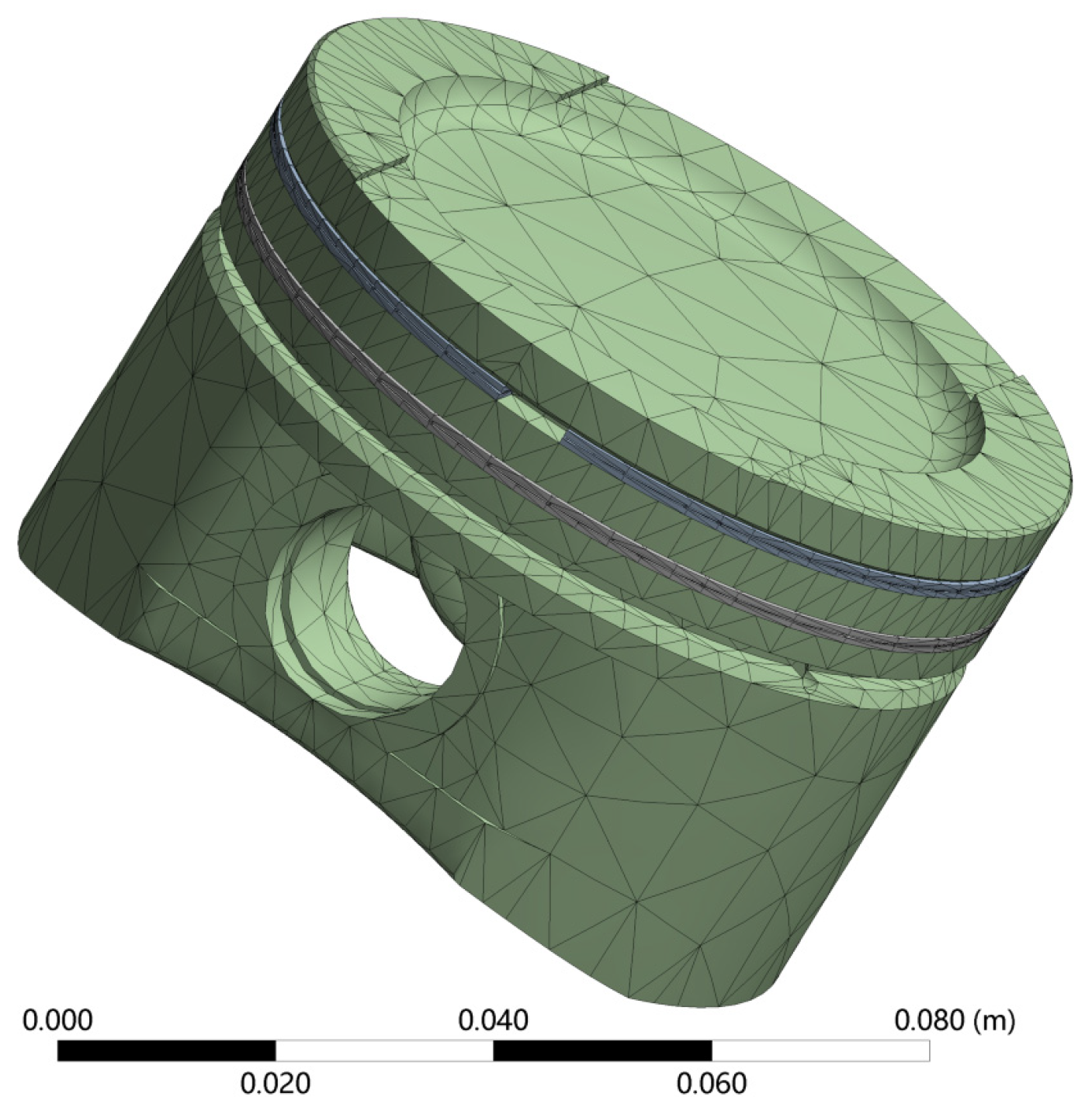
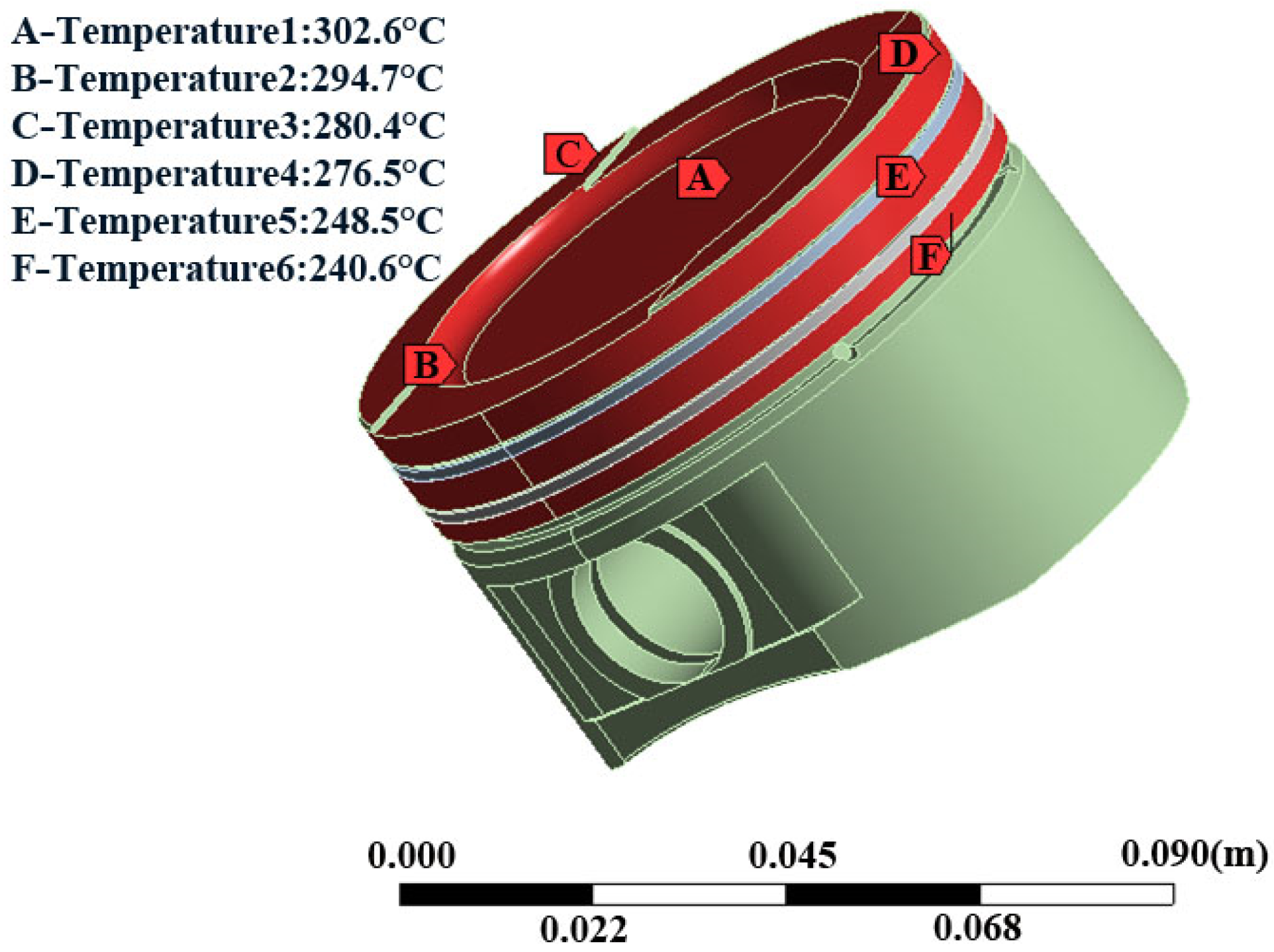
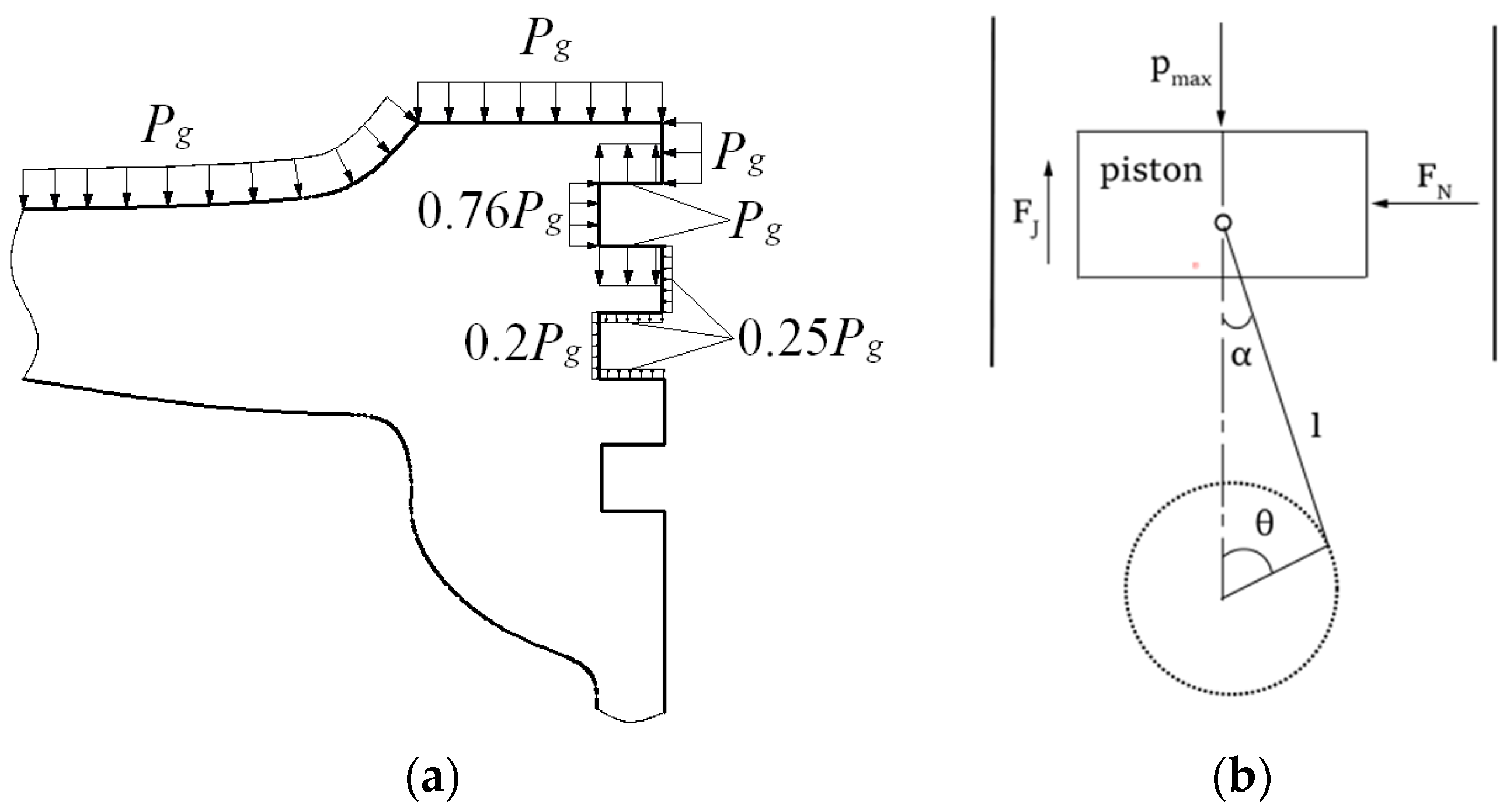
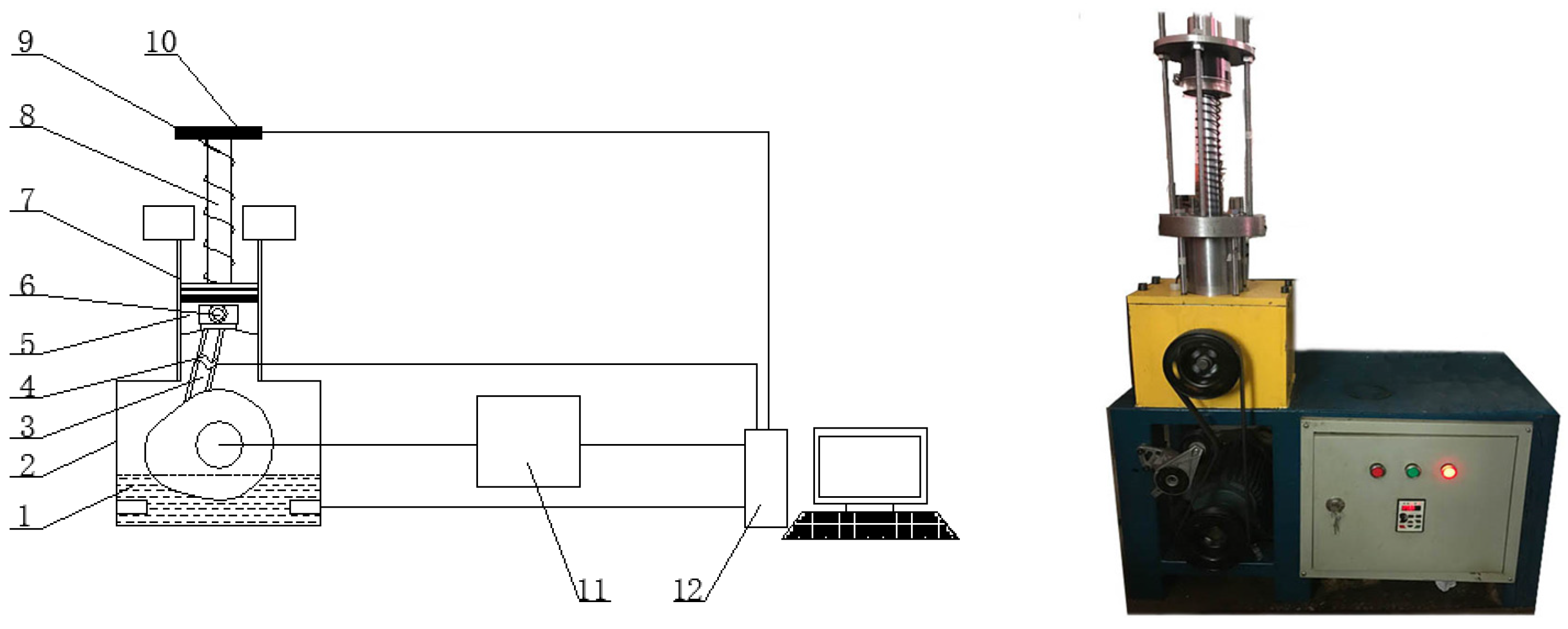
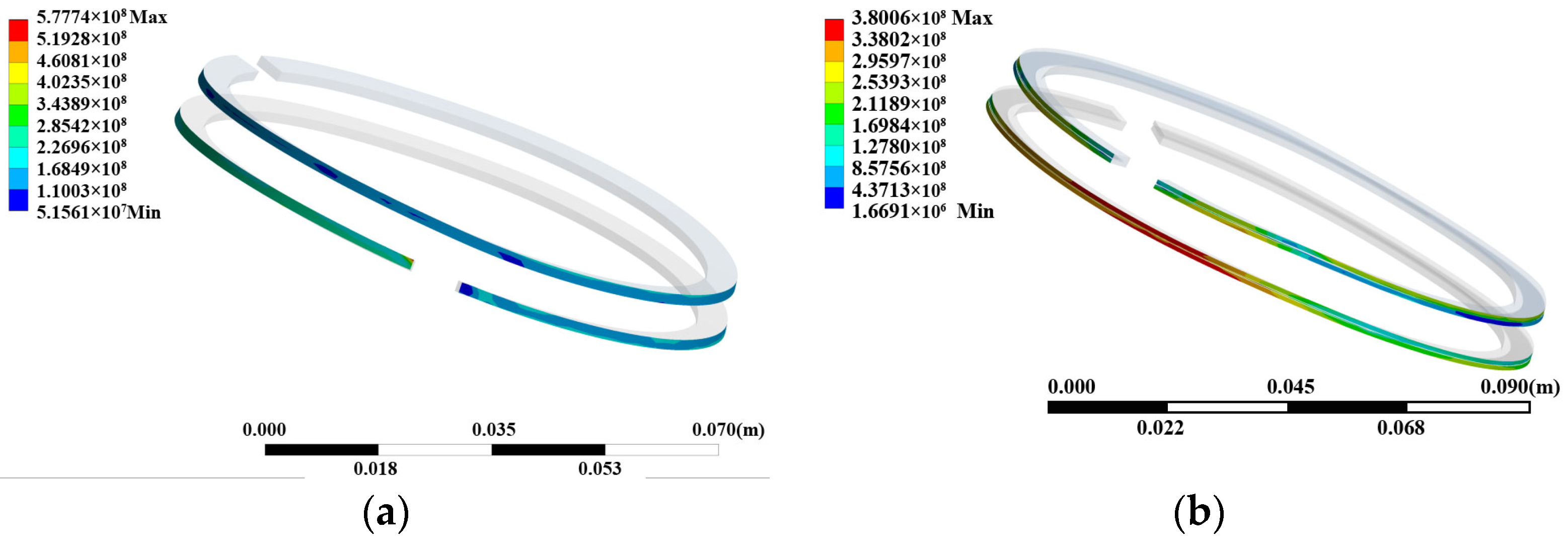

| Level | Depth D/mm | Width W/mm | Spacing L/mm |
|---|---|---|---|
| 1 | 1 (1) | 0.1 (1) | 0.1 (1) |
| 2 | 2 (2) | 0.3 (2) | 0.2 (2) |
| 3 | 3 (3) | 0.5 (3) | 0.3 (3) |
| Piston Ring Material | Stainless Steel 1Cr13 |
|---|---|
| Modulus of elasticity | 2.16 × 105 MPa |
| Poisson’s ratio | 0.28 |
| Densities | 7.77 × 103 kg/m3 |
| Shear modulus | 8.41 × 104 MPa |
| Yield strength | 5.45 × 102 MPa |
| Coefficient of thermal expansion | 1.13 × 10−5 1/K |
| Specific heat capacity | 0 J/(kg·K) |
| Heat conductivity | 0 W/(m·K) |
| Piston Material | Aluminum ZL108 |
|---|---|
| Modulus of elasticity | 7.0 × 104 MPa |
| Poisson’s ratio | 0.3 |
| Densities | 2.68 × 103 kg/m3 |
| Coefficient of thermal expansion | 2.35 × 10−5 1/K |
| Specific heat capacity | 460 J/(kg·K) |
| Variable | Specific Value |
|---|---|
| Air ring to cylinder liner clearance | 0.92 mm |
| Oil ring to cylinder liner clearance | 0.92 mm |
| Cylinder liner wall thickness | 7.1 mm |
| Air ring to ring bank clearance | 0.01 mm |
| Oil ring to ring bank clearance | 0.08 mm |
| Air ring heat transfer center spacing | 2.24 mm |
| Oil ring heat transfer center spacing | 2.18 mm |
| Air ring internal clearance | 0.15 mm |
| Oil ring internal clearance | 0.35 mm |
| Air ring height | 1.5 mm |
| Oil ring height | 1.62 mm |
| Oil film thickness | 0.005 mm |
| Lubricating oil heat transfer coefficient | 0.2 W/(m2·K) |
| Gas heat transfer coefficient | 0.12 W/(m2·K) |
| Cylinder liner heat transfer coefficient | 35.4 W/(m2·K) |
| Heat transfer coefficient of the gas ring | 51 W/(m2·K) |
| Oil ring heat transfer coefficient | 51 W/(m2·K) |
| Cylinder liner liquid heat transfer coefficient | 2700 W/(m2·K) |
| Radial width of the gas ring | 4.1 mm |
| Oil ring radial width | 3.8 mm |
| Depth D/mm | Width W/mm | Spacing L/mm | Friction f/N | Wear Resistance Improvement/% | |
|---|---|---|---|---|---|
| Standard piston ring | - | - | - | 12.967 | - |
| Bionic piston ring 2 | 1 | 0.1 | 0.2 | 11.633 | 10.29% |
| Bionic piston ring 12 | 2 | 0.1 | 0.3 | 11.789 | 9.08% |
| Bionic piston ring 19 | 3 | 0.1 | 0.1 | 11.422 | 19.63% |
| Bionic piston ring 20 | 3 | 0.1 | 0.2 | 10.963 | 17.52% |
| Bionic piston ring 21 | 3 | 0.1 | 0.3 | 11.022 | 15.00% |
| Bionic piston ring 23 | 3 | 0.3 | 0.1 | 11.233 | 13.37% |
Disclaimer/Publisher’s Note: The statements, opinions and data contained in all publications are solely those of the individual author(s) and contributor(s) and not of MDPI and/or the editor(s). MDPI and/or the editor(s) disclaim responsibility for any injury to people or property resulting from any ideas, methods, instructions or products referred to in the content. |
© 2023 by the authors. Licensee MDPI, Basel, Switzerland. This article is an open access article distributed under the terms and conditions of the Creative Commons Attribution (CC BY) license (https://creativecommons.org/licenses/by/4.0/).
Share and Cite
Tian, W.; Zhang, J.; Zhou, K.; Chen, Z.; Shen, Z.; Yang, X.; Cong, Q. Bionic Design and Optimization of the Wear-Resistant Structure of Piston Rings in Internal Combustion Engines. Lubricants 2023, 11, 484. https://doi.org/10.3390/lubricants11110484
Tian W, Zhang J, Zhou K, Chen Z, Shen Z, Yang X, Cong Q. Bionic Design and Optimization of the Wear-Resistant Structure of Piston Rings in Internal Combustion Engines. Lubricants. 2023; 11(11):484. https://doi.org/10.3390/lubricants11110484
Chicago/Turabian StyleTian, Weijun, Jinhua Zhang, Kuiyue Zhou, Zhu Chen, Ziteng Shen, Xiaobin Yang, and Qian Cong. 2023. "Bionic Design and Optimization of the Wear-Resistant Structure of Piston Rings in Internal Combustion Engines" Lubricants 11, no. 11: 484. https://doi.org/10.3390/lubricants11110484





